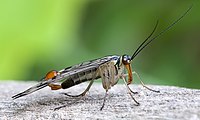
Photo from wikipedia
ABSTRACT Quantitative lung computed tomographic (CT) analysis yields objective data regarding lung aeration but is currently not used in clinical routine primarily because of the labor‐intensive process of manual CT… Click to show full abstract
ABSTRACT Quantitative lung computed tomographic (CT) analysis yields objective data regarding lung aeration but is currently not used in clinical routine primarily because of the labor‐intensive process of manual CT segmentation. Automatic lung segmentation could help to shorten processing times significantly. In this study, we assessed bias and precision of lung CT analysis using automatic segmentation compared with manual segmentation. In this monocentric clinical study, 10 mechanically ventilated patients with mild to moderate acute respiratory distress syndrome were included who had received lung CT scans at 5‐ and 45‐mbar airway pressure during a prior study. Lung segmentations were performed both automatically using a computerized algorithm and manually. Automatic segmentation yielded similar lung volumes compared with manual segmentation with clinically minor differences both at 5 and 45 mbar. At 5 mbar, results were as follows: overdistended lung 49.58 mL (manual, SD 77.37 mL) and 50.41 mL (automatic, SD 77.3 mL), P = .028; normally aerated lung 2142.17 mL (manual, SD 1131.48 mL) and 2156.68 mL (automatic, SD 1134.53 mL), P = .1038; and poorly aerated lung 631.68 mL (manual, SD 196.76 mL) and 646.32 mL (automatic, SD 169.63 mL), P = .3794. At 45 mbar, values were as follows: overdistended lung 612.85 mL (manual, SD 449.55 mL) and 615.49 mL (automatic, SD 451.03 mL), P = .078; normally aerated lung 3890.12 mL (manual, SD 1134.14 mL) and 3907.65 mL (automatic, SD 1133.62 mL), P = .027; and poorly aerated lung 413.35 mL (manual, SD 57.66 mL) and 469.58 mL (automatic, SD 70.14 mL), P = .007. Bland‐Altman analyses revealed the following mean biases and limits of agreement at 5 mbar for automatic vs manual segmentation: overdistended lung +0.848 mL (±2.062 mL), normally aerated +14.51 mL (±49.71 mL), and poorly aerated +14.64 mL (±98.16 mL). At 45 mbar, results were as follows: overdistended +2.639 mL (±8.231 mL), normally aerated 17.53 mL (±41.41 mL), and poorly aerated 56.23 mL (±100.67 mL). Automatic single CT image and whole lung segmentation were faster than manual segmentation (0.17 vs 125.35 seconds [P < .0001] and 10.46 vs 7739.45 seconds [P < .0001]). Automatic lung CT segmentation allows fast analysis of aerated lung regions. A reduction of processing times by more than 99% allows the use of quantitative CT at the bedside.
Journal Title: Journal of Critical Care
Year Published: 2017
Link to full text (if available)
Share on Social Media: Sign Up to like & get
recommendations!